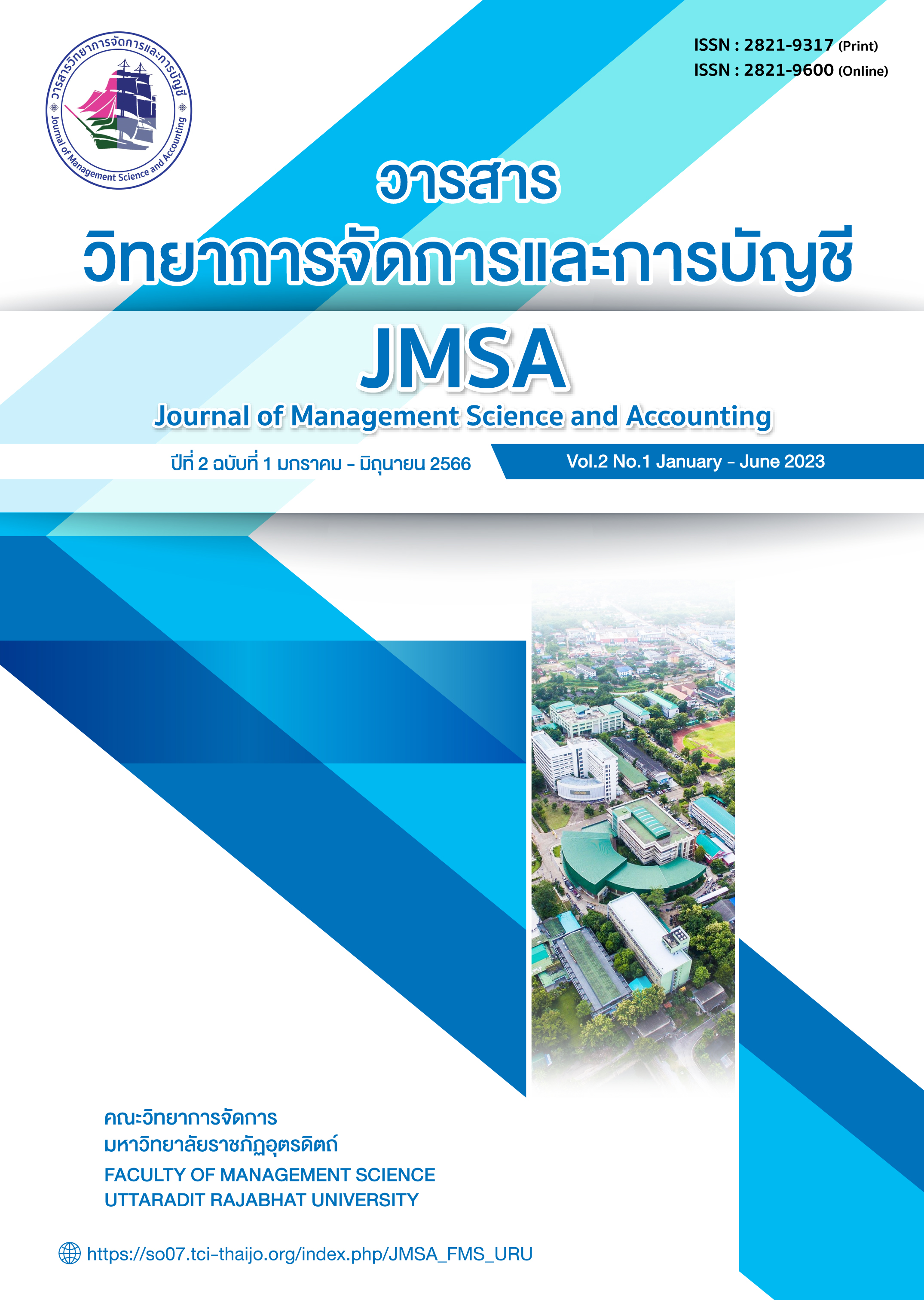ความสัมพันธ์เชิงสาเหตุของทัศนคติ และความพึงพอใจ ที่มีอิทธิพลต่อความเต็มใจ ในการใช้นวัตกรรมระบบบัญชีของสหกรณ์และกลุ่มเกษตรกรสามจังหวัดชายแดนใต้
Main Article Content
บทคัดย่อ
การวิจัยครั้งนี้มีวัตถุประสงค์เพื่อศึกษาความสัมพันธ์เชิงสาเหตุของทัศนคติ และความพึงพอใจ ที่มีอิทธิพลต่อความเต็มใจในการใช้นวัตกรรมระบบบัญชี โดยใช้แบบสอบถามเป็นเครื่องมือในการเก็บรวบรวมข้อมูลจากผู้บริหารฝ่ายบัญชีของสหกรณ์และกลุ่มเกษตรกรสามจังหวัดชายแดนใต้ จำนวน 210 คน ตัวแปรที่ใช้ในการวิจัย ประกอบด้วย ตัวแปรภายในแฝง 2 ตัวแปร คือความพึงพอใจ และความเต็มใจในการใช้นวัตกรรมระบบบัญชี ตัวแปรภายนอกแฝง 1 ตัว คือ ทัศนคติ วัดจากตัวแปรสังเกตได้ 10 ตัว แบบสอบถามที่ใช้เป็นเครื่องมือมีค่าสัมประสิทธิ์ความเที่ยงตั้งแต่ 0.770 ถึง 0.861 การวิเคราะห์ข้อมูลใช้เทคนิคการวิเคราะห์โมเดลสมการโครงสร้าง (SEM)
ผลการวิจัย พบว่า ปัจจัยที่มีอิทธิพลทางตรงและทางอ้อมต่อความเต็มใจในการใช้นวัตกรรมระบบบัญชีของสหกรณ์และกลุ่มเกษตรกรสามจังหวัดชายแดนใต้ คือ ทัศนคติ และผลการวิเคราะห์ข้อมูลยังพบว่า โมเดลการวิเคราะห์มีความสอดคล้องกับข้อมูลเชิงประจักษ์ แสดงถึงโมเดลมีความเหมาะสมพอดีกับข้อมูลเชิงประจักษ์อยู่ในเกณฑ์ดี ดังนั้น สหกรณ์และกลุ่มเกษตรกรควรให้ความสำคัญกับการสร้างประสบการณ์ในการเข้าถึงการใช้งานนวัตกรรมระบบบัญชีที่มีความสะดวก และง่ายในการใช้งาน เพื่อให้ผู้ใช้งานมีทัศนคติที่ดีในการใช้นวัตกรรมระบบบัญชี
Article Details

อนุญาตภายใต้เงื่อนไข Creative Commons Attribution-NonCommercial-NoDerivatives 4.0 International License.
บทความที่ได้รับการตีพิมพ์ในวารสารวิทยาการจัดการและการบัญชี มหาวิทยาลัยราชภัฏอุตรดิตถ์ เป็นลิขสิทธิ์ของมหาวิทยาลัยราชภัฎอุตรดิตถ์
บทความที่ลงตีพิมพ์ใน วารสารวิทยาการจัดการและการบัญชี มหาวิทยาลัยราชภัฎอุตรดิตถ์ ถือว่าเป็นความเห็นส่วนตัวของผู้เขียน คณะบรรณาธิการไม่จำเป็นต้องเห็นด้วย ผู้เขียนต้องรับผิดชอบต่อบทความของตนเอง
ผู้เขียนที่ตีพิมพ์ ยอมรับเงื่อนไขต่อไปนี้:
- ผู้เขียนรักษาลิขสิทธิ์และให้สิทธิ์วารสารในการตีพิมพ์ครั้งแรกพร้อมกับผลงานที่ได้รับใบอนุญาตพร้อมกันภายใต้ Attribution-NonCommercial-NoDerivatives 4.0 International (CC BY-NC-ND 4.0) ที่อนุญาตให้ผู้อื่นแบ่งปันผลงานโดยรับทราบถึงผลงานของผู้เขียนและ การตีพิมพ์ครั้งแรกในวารสารนี้
- ผู้เขียนสามารถทำข้อตกลงเพิ่มเติมตามสัญญาแยกต่างหากสำหรับการเผยแพร่ผลงานฉบับตีพิมพ์ของวารสารแบบไม่ผูกขาด (เช่น โพสต์ลงในพื้นที่เก็บข้อมูลของสถาบันหรือตีพิมพ์ในหนังสือ) โดยรับทราบการตีพิมพ์ครั้งแรก ในวารสารนี้
- ผู้เขียนได้รับอนุญาตและสนับสนุนให้โพสต์ผลงานของตนทางออนไลน์ (เช่น ในคลังข้อมูลของสถาบันหรือบนเว็บไซต์) ก่อนและระหว่างขั้นตอนการส่งผลงาน เนื่องจากอาจนำไปสู่การแลกเปลี่ยนที่มีประสิทธิผล ตลอดจนการอ้างอิงงานที่ตีพิมพ์เร็วขึ้นและมากขึ้น
เอกสารอ้างอิง
กรมส่งเสริมสหกรณ์. (2564). สารสนเทศกรมส่งเสริมสหกรณ์. ค้นเมื่อวันที่ 30 มิถุนายน 2565, จาก: https://www.cpd.go.th/information-cpd/info-data-cpd.html.
ละออ มามะ และนันทา จันทร์แก้ว. (2563). ปัญหาการบริหารความเสี่ยงผู้ตรวจสอบบัญชีสหกรณ์และกลุ่มเกษตรกรจังหวัดยะลา. WMS Journal of Management Walailak University, 9(2), 59-71.
Aaker, D. A., Kumar, V., and Day, G. S. (2001). Marketing Research. New York: John Wiley and Son.
Barclay, D., Higgins, C. and Thompson, R. (1995). The partial least squares (PLS) approach to causal modeling: Personal computer adoption and use as an illustration. Technology studies, 2(2), 285-309.
Chow, W. S., and Chan, L. S. (2008). Social network, social trust and shared goals in organizational knowledge sharing. Information and Management, 45(7), 458-462.
Fornell, C., and Larcker, D. F. (1981). Evaluating structural equation models with unobservable variables and measurement error. Journal of Market Research, 18(1), 39-50.
Grant, D., Jha, P. P., Wanjiru, R. & Bhalla, A. (2020). Evolving willingness and ability
interfaces: An innovation led transformation journey. International Journal of Innovation Studies, 4(2020), 69-75.
Griffiths, A., Holderfield-Gaither, E., Funge, S. P., & Warfel, E. T. (2021). Satisfaction, willingness, and well-being: Examining the perceptions of a statewide sample of public and private foster parents. Children and Youth Services Review, 121(4), 2-10.
Hair, J.F., Black, W.C., Babin, B.J. and Anderson, R.E. (2010). Multivariate data analysis: A global perspective. (7th ed.). New Jersey: Pearson Education Inc.
Jan, C. F., Lee, M. C., Chiu, C. M., Huang, C. K., Hwang, S. J., Chang, C. J., & Chiu, T. Y. (2020). Awareness of, attitude toward, and willingness to participate in pay for performance programs among family physicians: a cross-sectional study. BMC Family Practice, 21(1), 1-9.
Jiang, X., Goh, T. T., & Liu, M. (2022). On Students’ Willingness to Use Online Learning: A Privacy Calculus Theory Approach. Frontiers in Psychology, 13, 1-11.
Koh, B., Raghunathan, S., & Nault, B. R. (2020). An empirical examination of voluntary profiling: Privacy and quid pro quo. Decision Support Systems, 132(2020), 12-22.
Nunnally, J. C. (1978). Psychometric theory. New York: McGraw-Hill.
Nunnally, J. C. & Bernstein, I. H. (1994). Psychometric Theory. (3rd ed.). New York, NY: McGraw-Hill.
Schumacker, R.E. and Lomax, R.G. (2010). A beginner’s guide to structural equation modeling. (3rd ed). New Jersey: Lawrence Erlbaum Associates.


